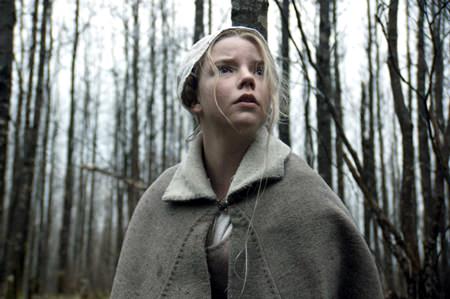Los Angeles (AP) – Set under gray Puritan skies in a deathly autumn, “The Witch” is a slow-burning 1600s horror thriller so bone-dry it would only take a match for the whole movie to go up in flames.
“A New England folktale” is how the opening titles describe writer-director Robert Eggers’ impressively rigorous feature debut. The film doesn’t just take place in early 17th century America, but it has effectively summoned the nightmares and superstitions of the era, much of which Eggers faithfully reproduced from various historical sources.
 This photo shows Anya Taylor-Joy as Thomasin in a scene from the film, “The Witch.” (Rafy/A24 via AP)
This photo shows Anya Taylor-Joy as Thomasin in a scene from the film, “The Witch.” (Rafy/A24 via AP)
The subject here is less witches as some supernatural fright than the Puritan psychology that dreamed them. Do not expect broomsticks.
A family, led by a prideful patriarch, William (Ralph Ineson, terrific), is banished from the plantation after his stubborn refusal to accept common law as above his own, superior piety. “I would be glad of it,” he seethes when threatened with expulsion.
Our images of the settlement are fleeting. The eldest of the five children, Thomasin (Anya Taylor-Joy, in a breakout performance) peers backward as the wooden gates close behind them as they ride out. The picture is drained of color and the score (by Mark Korven) is eerie and discordant: trouble waits outside the gates.
After setting up a scrappy existence in the wilderness, misfortunes mount. The crops die and when Thomasin takes the newborn out near the forest, the child vanishes. That night, after frantic searching, an image flickers of a witch-like figure floating toward a full moon.
A spell of mysterious source seems to have settled over the family that spookily manifests in various farm animals: a rabbit in the woods, a bloody chick in an egg. Eventually, a goat and a crow get in on the act. A suitably creepy set of toddler twins is here, too.
As things get steadily worse and demons seem literally at the door, the faith of the family is tested. Suspicions begin falling on Thomasin, a fair, pale-white girl whose growth into womanhood is drawing the curious gaze of her younger brother, Caleb (Harvey Scrimshaw). Could she be a witch?
The spell is cast over the viewer, too, as the authentically resurrected world of “The Witch” transports to a time of suffocating fear, born out of a harsh new land and hardened religious fervor. Taking place decades before the Salem witch trials, “The Witch” is a kind of horror chamber piece, a stripped-bare prequel to the forces that propel Arthur Miller’s “The Crucible” and Nathaniel Hawthorne’s “The Scarlet Letter.”
The characters speak in the formal diction of the period — lots of “thees” and such. It’s a kind of time travel, for those looking for a far grimmer trip to colonial America than New England tourist attractions afford. It is, to say the least, not a barrel of laughs.
But what makes “The Witch” more than a mere museum reclamation project is Taylor-Joy. The movie is in many ways seen through Thomasin, who stands apart from her devote family. Wide-eyed and rebellious, she more resembles a girl of today.
Whether she is, in fact, a witch remains in suspense. But we witness how Puritan paranoia and misogyny turns a pretty young woman like Thomasin into a fearsome seductress in the eyes of her family.
When the combustible “The Witch” finally lets itself ablaze, the brutal and surprisingly sober finale is also — and more thrillingly — Thomasin’s awakening. Drawn by the lure to break free of her upbringing, to “live deliciously,” she turns out to be something scarier than the Puritans could fathom: a teenager.
“The Witch,” an A24 release, is rated R by the Motion Picture Association of America for “disturbing violent content and graphic nudity.” Running time: 92 minutes. Three stars out of four.




